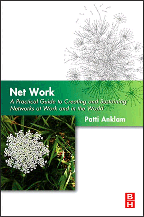ABCs from Collaboration to Complexity
One of the insights that came to me toward the end of the KM Cluster on the 21st was the juxtaposition of two alphabetical lists. Andrew Laing of DEGW talked about the need of the physical environment to support social networks. He elucidated the ways that we must measure the performace of work environments as:
- Efficiency, effectiveness, and expression (I just loved this expression bit)
Bill Ives categorized the functions of blogs as:
- Content creation, Collection, Context, Connection, Conversation, Community, and Collaboration (very similar to Stowe Boyd’s 4 Cs of social software: Communication, Coordination, Collaboration, Community)
Although the conversation of the day didn’t discuss the important Ds (discovery and diversity), there were even more Es:
- Emergent, Evolutionary
I’m reading some complexity papers and thinking about the Cynefin framework, and will add, for today, “Environment,” which poses particular problems in Engineering.
(As an aside, many people use the Boeing 747 as the example of complicated when distinguishing complex and complicated — whoops! 2 more Cs — but I love this example from a Nature Magazine article by J.M. Ottino:
It should be stressed that complex is different from complicated. The most elaborate mechanical watches are appropriately called tres complique, for example the Star Caliber Patek Philippe has 10**3 parts.
He also makes another interesting distinction that a key defect in a complicated system is that a single component can bring the entire system to a halt. I knew that, but like to be reminded.)





1Shawn
wrote on 30 January 2005 at 11:08
Hi Patti, It is great to see another blogger who is interested in the application of complexity theory to management practice. Thanks for the link to the nature paper. I’m doing some work for a mining company which is full of engineers and I think they would appreciate it. BTW what Cynefin papers are you reading?
2christianhauck
wrote on 31 January 2005 at 2:34
The great watch metaphors:
If you find a broken watch, is this a proof for the existence of a blind watchmaker?
What about an hourglass. Many grains of sand, similar to each other, not a single one is critical … complicated? Complex? Simple?
The answers are less important, I think.
3theinformationauditor
wrote on 2 February 2005 at 12:15
Emergence and the possible applications for management and organizational science are fascinating topics. I wonder, though, just how applicable complexity and emergence theory can be applied when we look at human systems. I’ve been reading articles on http://www.emergence.org/ as well as the very fine book by Steven Johnson, “Emergence: The Connected Lives of Ants, Brains, Cities, and Software”. My thinking of complexity theory’s application to management (as brought up by Shawn) was mostly inspired and informed from those readings.
I read the J.M. Ottino article referenced above by Patti and I have to say it raised some issues for me. First, the author stated that “(t)he hallmarks of complex systems are adaptation, self-organization and emergence…” which is fair enough. Such a statement sounds great for management people because, heck, that’s what management is all about, adapting, organizing, etc. However, what the author missed is that emergent systems require dumb agents (that’s my understanding). And that’s my basic problem with notions of proactive application of emergence theory to organizations of people: people, generally, aren’t dumb agents. They make unpredictable choices and if you have that going on it is unlikely a shepherding principle for “managed complexity” would work –the assumption, that you could align, guide, even trick non-dumb agents into creating a 747 is flawed in that respect.
I could say a few things about that author’s (J.M. Ottino) ideas about engineering since I work at a very large manufacturing engineering company on the west coast (that builds airplanes). But, I’ll leave that for my own blog (http://www.theinformationauditor.com).
PS: Patti, you have a very nice blog and I learn from it quite a lot. Keep up the nice work.